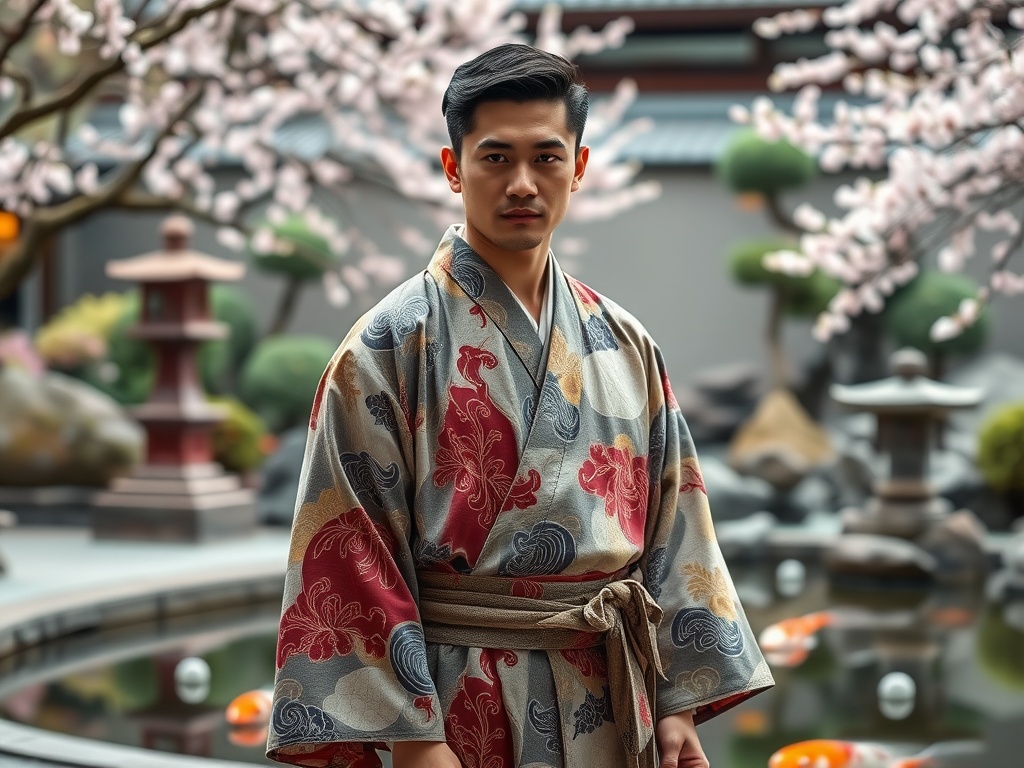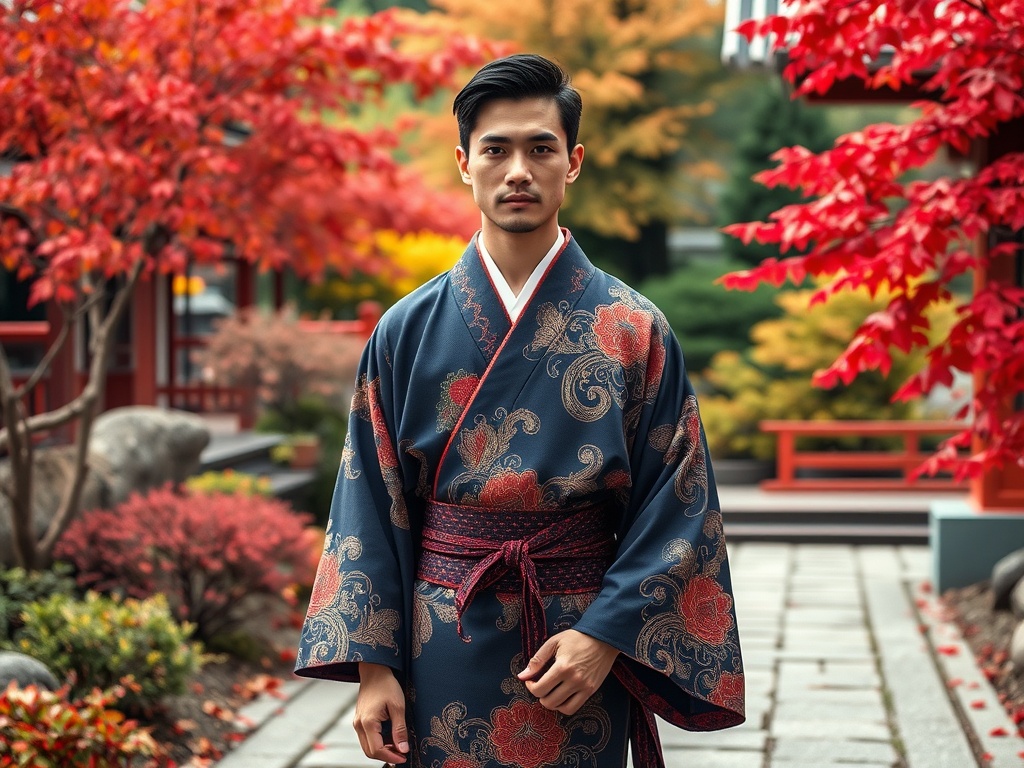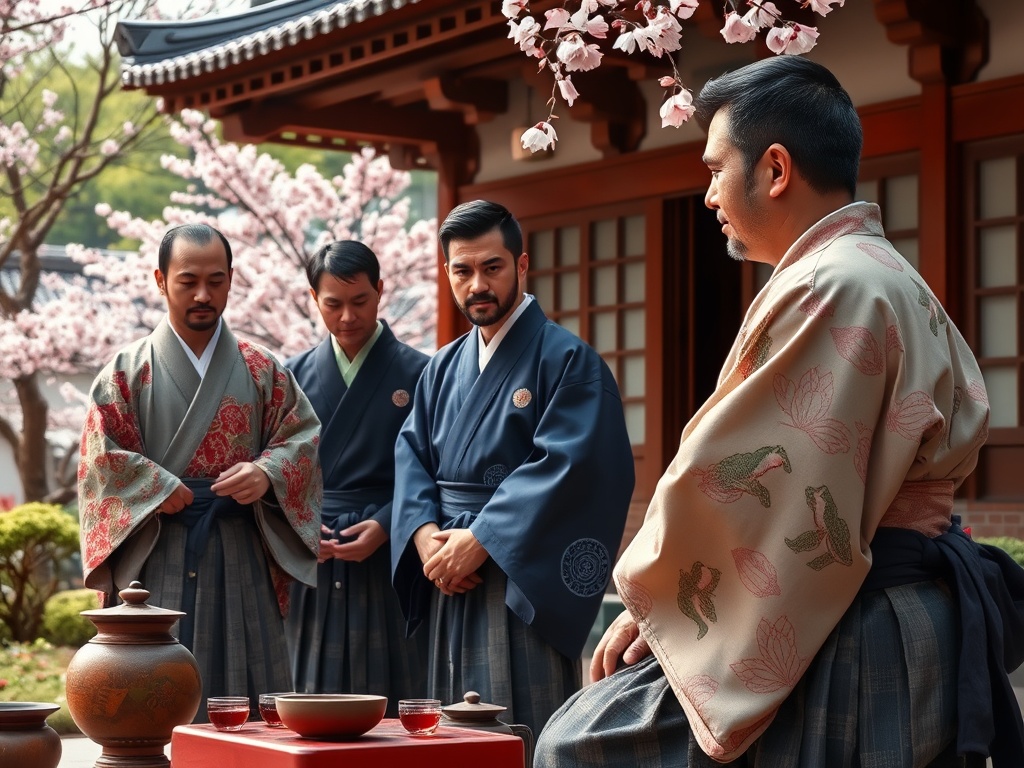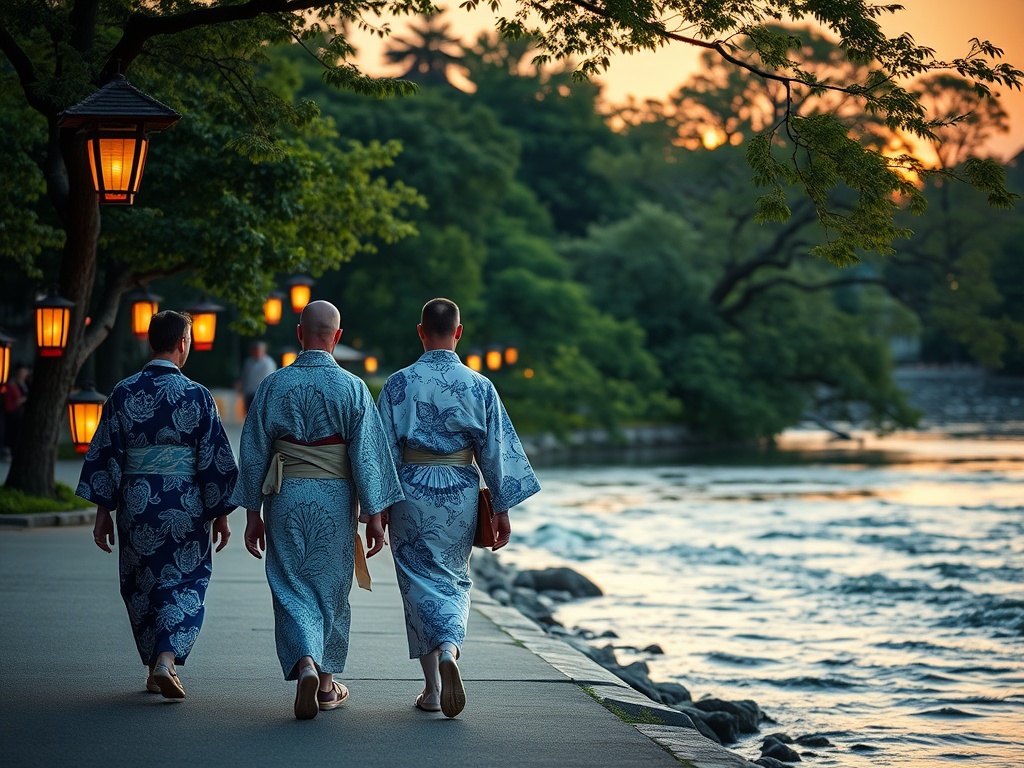Unraveling the Kimono: The Quintessential Japanese Attire for Men
Win a Free Trip to Japan!
Experience cherry blossoms and ancient temples
Embark on a sartorial journey through time and explore the elegant world of men’s traditional Japanese clothing, where the iconic kimono stands as a testament to cultural heritage and timeless style. This article invites travel and tourism enthusiasts to delve into the layers of history, craftsmanship, and symbolism that make the men’s kimono an enduring symbol of Japanese identity.
The kimono, a garment synonymous with Japanese culture, is more than just a piece of clothing—it’s a woven narrative of Japan’s rich history. Originating in the Heian period (794-1185), the kimono’s design has evolved over centuries, adapting to the shifting tides of fashion and social norms. Traditionally crafted from silk, the men’s kimono is characterized by its straight seams and wide sleeves, embodying both simplicity and elegance. Each kimono tells a story, with patterns and colors that once denoted the wearer’s social status and personal identity.
Wearing a kimono is an art unto itself, requiring a certain finesse to ensure it is donned correctly. Unlike Western clothing, the kimono wraps around the body from left to right and is secured with an obi (a wide belt). This meticulous process is a reflection of the discipline and harmony that underpin Japanese culture. Whether attending a traditional tea ceremony or a festive celebration, mastering the kimono is a rite of passage for those wishing to immerse themselves in Japanese tradition.
- Essential Components of a Men’s Kimono:
- Nagajuban: An undergarment worn beneath the kimono.
- Haori: A short coat worn over the kimono for formal occasions.
- Hakama: Traditional trousers worn over the kimono, often seen in ceremonies.
- Geta: Wooden sandals typically worn with the kimono.
In today’s Japan, the kimono is experiencing a renaissance, blending tradition with modern aesthetics. Designers are reimagining this ancient garment, incorporating contemporary fabrics and styles that appeal to a new generation. While the kimono remains a staple in festivals and cultural events, it is also being embraced in everyday fashion, symbolizing a fusion of past and present. For travelers, purchasing a kimono or yukata (a lighter, casual version) serves as both a souvenir and a connection to Japan’s enduring cultural legacy.
The Hakama Mystery: More Than Just Samurai Skirts
Step into the world of traditional Japanese attire, and the hakama stands out as a garment shrouded in mystery and historical significance. Often mistaken for a simple skirt, the hakama is a vital component of Japanese heritage, woven deeply into the tapestry of the country’s cultural evolution. For travel and tourism enthusiasts, understanding the hakama is akin to uncovering a secret chapter of Japan’s sartorial history, where each fold and pleat tells a tale of its own.
While the hakama is popularly associated with samurai, its origins and use extend far beyond the battlefield. Traditionally worn by men during the Heian period, the hakama was a symbol of rank and authority, signifying the wearer’s status within the complex hierarchy of Japan’s feudal society. The garment’s design, with its bifurcated legs, allowed for ease of movement, making it an ideal choice for both warriors and noblemen. In the modern era, the hakama continues to be a staple in martial arts such as kendo and aikido, where it is revered not only for its practicality but also for its deep-rooted connection to Japanese tradition.
The hakama is more than meets the eye, embodying a rich tapestry of symbolism and style. It is traditionally crafted in a variety of colors and patterns, each with its own significance. The pleats, often numbering seven, are said to represent the virtues of bushido, the samurai code of conduct: courage, integrity, benevolence, respect, honesty, honor, and loyalty. This alignment with the samurai ethos gives the hakama a timeless appeal, one that resonates with those who appreciate the depth of Japanese culture. For the traveler, wearing a hakama during a cultural festival or martial arts demonstration offers a unique glimpse into the disciplined world of the samurai, where every garment choice is a reflection of inner values.
In contemporary Japan, the hakama is experiencing a revival, much like the kimono. Its versatility and cultural significance have made it a popular choice for formal occasions, including weddings and graduation ceremonies. Designers today are exploring innovative ways to blend traditional elements of the hakama with modern fashion sensibilities, creating garments that appeal to a younger audience. For those visiting Japan, acquiring a hakama not only serves as a unique souvenir but also as a tangible connection to the country’s dynamic history and cultural legacy.
Yukata Chronicles: Summer’s Breath in Japanese Fashion
The yukata, a summer kimono, breathes life into Japan’s warm months with its light, airy fabric and vibrant designs. Embracing this garment is akin to embracing the soul of Japanese summer festivals, where the air is fragrant with the scent of street food and the sky alights with fireworks. For the travel and tourism enthusiast, the yukata offers not only comfort but also an immersive experience into Japan’s cultural festivities.
The yukata is celebrated for its simplicity and ease of wear, making it a perfect choice for summer events. Unlike the formal kimono, the yukata is typically made from cotton or synthetic fabric, which is breathable and ideal for the humid Japanese summers. Its design is often less restrictive, featuring a single layer that wraps around the body and is secured with an obi. This garment’s charm lies in its vibrant patterns, ranging from geometric shapes to nature-inspired motifs, each telling a story of the wearer’s personality and the season’s essence.
As summer unfolds, the yukata becomes a staple in Japan’s colorful festival landscape. Matsuri (festivals) provide the perfect backdrop to showcase the yukata’s splendor, as locals and tourists alike don the attire to participate in festivities. From dancing at the Bon Odori to strolling through bustling yatai (food stalls), wearing a yukata is a way to blend into the rhythmic pulse of Japanese summer culture.
- Popular Yukata Occasions:
- Hanabi Taikai (Firework Festivals): Experience the magic of fireworks while adorned in a yukata.
- Tanabata (Star Festival): Celebrate this event under the night sky in a traditional yukata.
- Obon: Honor the spirits of ancestors while wearing this symbolic clothing.
In recent years, the yukata has transcended its traditional roots, finding a place within modern fashion circles. Designers across Japan are reinterpreting this classic garment, introducing innovative patterns and styles that appeal to the modern man. This fusion of old and new ensures the yukata remains a dynamic part of Japan’s cultural wardrobe. For travelers, purchasing a yukata serves as both a keepsake and a gateway to experiencing Japanese culture firsthand.
Traditional Footsteps: The Art of Men’s Tabi and Geta
In the vibrant tapestry of traditional Japanese attire, the journey begins from the ground up, quite literally, with the distinctive footwear that completes the ensemble: the tabi and geta. These unique pieces are more than just functional; they are an essential part of Japan’s cultural narrative, each step echoing the rhythms of history and heritage. For those with a passion for travel and tourism, exploring these elements offers an intriguing glimpse into the nuanced layers of Japanese tradition.
The tabi, traditional Japanese socks, are renowned for their split-toe design, which not only provides comfort but also allows for the wearing of geta and other traditional footwear. Crafted primarily from cotton, these socks are a staple in traditional attire, bridging the gap between comfort and cultural expression. The design of tabi has remained largely unchanged through the centuries, offering a tactile connection to Japan’s past. For the traveler, donning a pair of tabi is akin to stepping into the shoes of those who have walked this path for generations, each step a testament to the blend of practicality and elegance that defines Japanese clothing.
Complementing the tabi are the geta, iconic wooden sandals that are synonymous with the sound of Japan’s cobbled streets. These sandals, characterized by their elevated soles, serve both functional and symbolic purposes. The distinctive clacking sound of geta on pavement is a melody that has resonated through time, evoking images of bustling markets and serene temples. Wearing geta requires a unique balance, both physically and culturally, offering a dynamic experience for those seeking to immerse themselves in Japanese customs. For the travel enthusiast, walking in geta is an invitation to experience Japan’s vibrant history through each resonant step.
Together, the tabi and geta form an integral part of the traditional Japanese attire, harmonizing with the kimono to create a cohesive cultural statement. This footwear is not just about style; it is a journey through time, inviting travelers to walk the paths of history with every step they take.
Jinbei: The Casual Elegance of Japanese Nightwear
Amidst the intricate layers of traditional Japanese clothing, the jinbei emerges as a symbol of effortless style and comfort. Known for its casual elegance, the jinbei is a staple of Japanese nightwear, offering a unique blend of tradition and relaxation. For travel and tourism enthusiasts, exploring the jinbei provides a window into the more intimate aspects of Japanese culture, where clothing is not only a public display but a private comfort.
The jinbei, traditionally worn as nightwear or loungewear, consists of a kimono-style top paired with loose-fitting shorts or pants. Made from breathable materials like cotton or hemp, it is ideal for Japan’s humid summers. The garment’s simplicity and ease of wear make it a favorite for informal gatherings, summer festivals, and even as casual daywear. For travelers, the jinbei offers a chance to embrace the relaxed yet culturally rich lifestyle of Japan, where comfort is as valued as aesthetics.
In contemporary Japan, the jinbei is more than just attire; it is an expression of cultural heritage. Often adorned with subtle patterns or traditional motifs, the jinbei reflects the wearer’s personality and a connection to Japan’s artistic traditions. Its popularity in summer festivals, like the Obon and Tanabata, underscores its role in bridging modern and traditional lifestyles. For those visiting Japan, donning a jinbei is not just about blending in but about immersing oneself in the heart of Japanese summer evenings, where every breeze carries whispers of history.
For the discerning traveler, acquiring a jinbei is more than purchasing a piece of clothing; it is about capturing the essence of Japanese culture. As a souvenir, it represents a tangible connection to Japan’s rich sartorial traditions, offering a piece of the country that can be carried back home. The jinbei’s enduring appeal lies in its ability to transcend time and trend, making it a cherished addition to any cultural wardrobe. Whether worn as pajamas or casual attire, the jinbei invites you to experience a slice of Japan’s unpretentious elegance.
Beyond the Fabric: The Cultural Significance of Men’s Obi
Venture into the world of traditional Japanese attire, and the obi emerges as a pivotal element in understanding the cultural depth and aesthetic principles that define men’s kimono. This wide, decorative sash is more than a functional piece; it is a symbol of artistry and identity, playing a crucial role in the overall elegance and significance of the ensemble. For travel and tourism enthusiasts, the obi offers a fascinating insight into the complex layers of Japanese tradition, where each fold and knot tells a story of its own.
The obi is an artwork in its own right, with a rich history that reflects the intricate techniques and symbolism deeply embedded in Japanese culture. Traditionally crafted from silk or other luxurious fabrics, the obi’s design and method of tying can convey a myriad of meanings. Various knots and styles, such as the simple taiko musubi or the elaborate kikko musubi, not only demonstrate the wearer’s skill but also signify different occasions and social statuses. For the traveler, understanding the nuances of the obi’s presentation offers a window into the disciplined elegance of Japanese sartorial practices.
In modern Japan, the obi continues to captivate with its blend of tradition and innovation. Contemporary designers are reimagining this classic accessory, incorporating modern materials and patterns that appeal to today’s fashion-forward individuals. This fusion of past and present ensures the obi remains an integral part of both formal and casual attire, resonating with those who appreciate the depth and beauty of Japanese culture. For those visiting Japan, purchasing an obi serves as a meaningful memento, a piece that embodies the timeless elegance of Japanese heritage.



